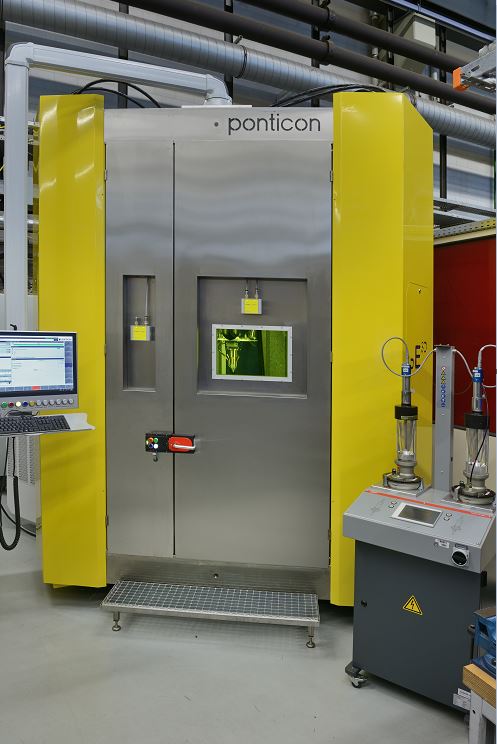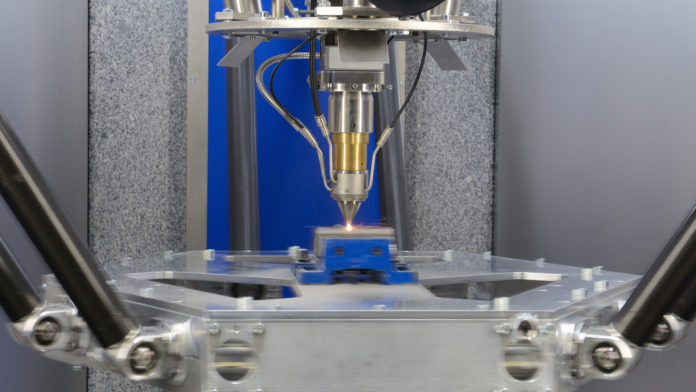We recently learned about EHLA 3D, an “Extreme High-speed Laser Material Deposition” process described as an “efficient and environmentally friendly alternative to conventional cladding processes”.
Developed by research institute Fraunhofer ILT – Institute of Laser Technology, in collaboration with machine manufacturer Ponticon GmbH, this manufacturing process for deposition of metal – as the name implies – uses lasers.
As seen in most deposition processes, in this process, a powerful laser beam hits powder while melting the metal which is thereafter deposited on a nearby surface. However, unlike other conventional laser material deposition methods, researchers at Fraunhofer ILT have focused the main benefits of this novel method on three items: speed, thinness of layers, and low heat input.
Those advantages are a particular good fit for coating metallic components that are subject to extreme stress and, therefore, need to be protected from corrosion and wear.
The feed rate at which the surface is processed is much faster here – moving from 0.5 to 2 meters per minute in conventional laser material deposition all the way up to 50 to 500 meters per minute. A component can, therefore, be coated 100 to 250 times faster today. It is also possible to apply significantly thinner layers.
It is also possible to apply significantly thinner layers. While layers of at least 500 micrometers were state of the art with conventional laser material deposition, a minimum of 25 micrometers is now possible.
As far as the low heat input is concerned, it should be noted that in conventional laser material deposition, the powdered filler material is melted directly on the component surface in a relatively large melt pool in the coating process. However, this can permanently change the material properties and costs a great deal of energy. Not so with EHLA: Here, the solid powder particles are melted by the laser while still in the air. They reach the surface of the component in a liquid state and do not have to be melted further with a high energy input. As a result, the heat-affected zone is reduced to five to ten micrometers, which is only one hundredth compared to the conventional process.
This means that metallurgically incompatible, heat-sensitive material pairings can now be joined and processed together, such as aluminum and titanium. Overall, the component surface also becomes much smoother. Its roughness is only one tenth of that from conventional deposition. For the experts at the Fraunhofer ILT, this provides a perfect basis for further development steps.
”In principle, EHLA is suitable for everything that is rotationally symmetrical and can be machined on a fast rotary kinematic system,” says Jonathan Schaible, research associate at Fraunhofer ILT. “The only question is why we should limit ourselves to simple round parts when a much wider range of possible applications is conceivable?”
Focus on the collaboration with Ponticon GmbH

The first prototype of the system is already successfully in use. It was completed in 2019 in cooperation with Ponticon GmbH from Wiesbaden, Germany. The concept for it is based on the kinematic principle of the tripod, a construction with three linear motors that are connected via coupling rods to the building platform on which the component to be processed is moved. “It works in a similar way to the Transrapid magnetic levitation train,” Schaible explains.” The special structure compensates for the inertial forces to a large extent. In our case, this allows the construction platform to make very fast and precise movements without causing any major vibrations. As of today, the system can thus process components weighing up to 25 kilograms – with up to five times the acceleration due to gravity and speeds of up to 200 meters per minute, while at the same time achieving a very high precision of 100 micrometers. With conventional laser material deposition, just 0.5 to 2 meters per minute are common.
”In order to make the advantages of EHLA 3D available to a large group of users in the industrial environment, Fraunhofer ILT is currently conducting targeted research work,” says Schaible. ”Along the way, we need to find ways to manage complexity.”
Central to this are, for example, process monitoring concepts and automated path planning tools, but parameter variation remains the most important in the laboratory for the time being. During process development, all parameters must be precisely coordinated: speed, laser power and powder quantity depending on the material combination being processed in each case. “There is still a lot of experimental and empirical preliminary work to be done. However, the first interested parties from industry have already put out their feelers,” says Schaible optimistically. “So we know we are on the right track.”
Remember, you can post job opportunities in the AM Industry on 3D ADEPT Media free of charge or look for a job via our job board. Make sure to follow us on our social networks and subscribe to our weekly newsletter: Facebook, Twitter, LinkedIn & Instagram ! If you want to be featured in the next issue of our digital magazine or if you hear a story that needs to be heard, make sure you send it to contact@3dadept.com






